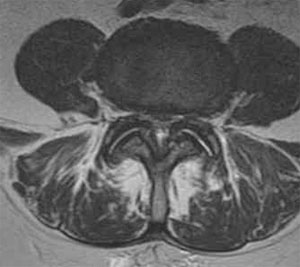Contact ☎ 310.448.7844
LAMINECTOMY
Laminectomy, sometimes abbreviated as ‘Lami”, is a decompression-type surgery whereby the lamina is removed. The root ‘ectomy’ refers to removal and ‘lamina’ is a sheet of bone that partially forms the spinal canal. Patients with the diagnosis of stenosis are candidates for a laminectomy.
The surgery is designed to decompress a narrowed, or stenotic, spinal canal. This stenosis is the result of degeneration in the spine which causes disc bulging, thickening of ligaments and joint capsules, and bone spur formation. Imagine a cross-section of the spinal canal as being a simplified 2-dimensional house with a floor, 2 side walls, and a roof. The nerves run through the house like a train through a tunnel. When a patient has stenosis, the roof of the house is collapsed and constricts the nerves. The extent of the roof collapse depends on the extent of the stenosis which in turn determines the extent of the laminectomy. Sometimes only partial laminectomies may be needed, while other times necessitate a complete laminectomy.
Eighty-nine percent of our patients have had pain reduction with a laminectomy with an average pain reduction from 7/10 pre-op to 3/10 post-op.
MICROSCOPIC LUMBAR LAMINOTOMY
Case Study
This is a case of a 72 year-old male who complained of standing and walking pain that was relieved with forward flexion type maneuvers like bending, squatting, or lifting a leg up upon a step. The pain began in the low back and radiated into the bilateral buttocks and the back of his thighs. It would begin within 10 minutes of standing, most notably while standing in-line at places like the bank or supermarket. His MRI demonstrated severe stenosis at the L4-5 (Figure 1). Figure 2 demonstrates an MRI image through his normal L2-3 level. He had failed non-surgical management in the form of medications, injections, and physical therapy. He ultimately underwent a laminectomy at the L4-5 level with significant improvement in his standing and walking tolerance. He is now able to stand for over an hour without leg or back pain.


